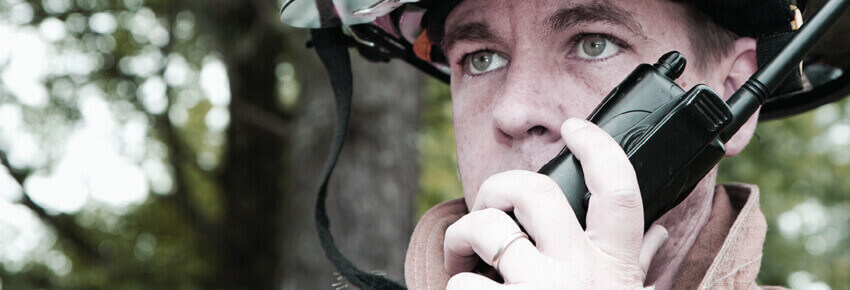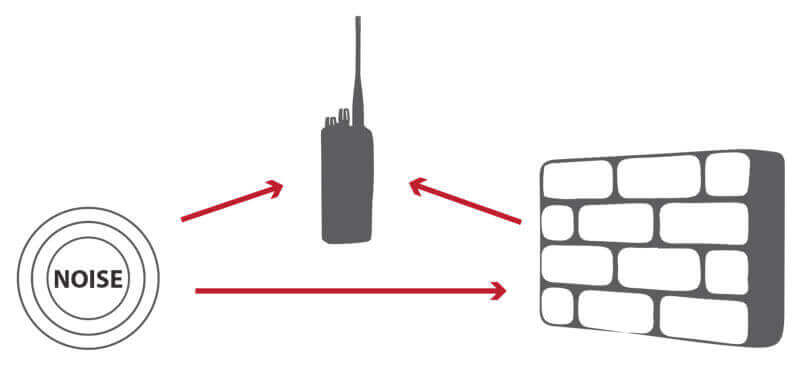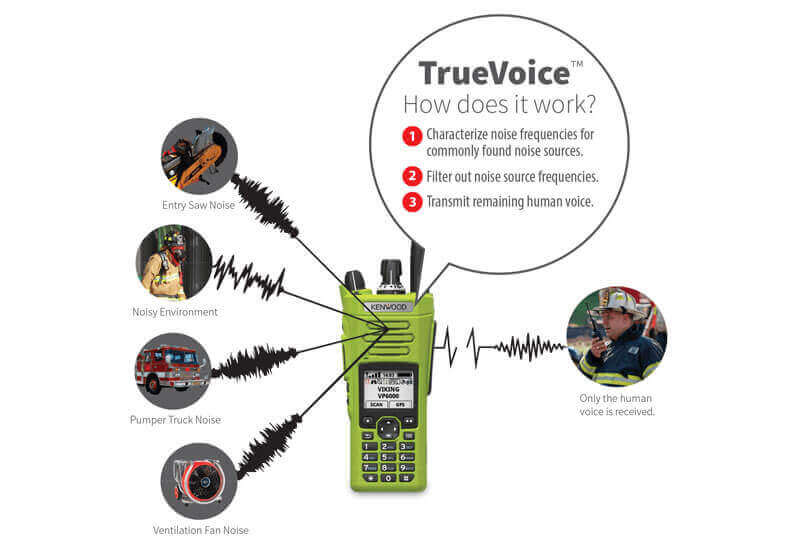
The Challenge of Noisy Environments
First responders often must work in noisy environments. Having radio communications with clear audio can often be a matter of life or death. It is imperative that emergency radio dispatchers can understand first responders even in the most challenging noise environments.
The Land Mobile Radio (LMR) industry has invested heavily in developing technology to improve the voice clarity of first responders’ radio signals when operating in high noise environments. The most common way to solve this problem is to add more hardware to the radio. One approach adds a second microphone to each radio to capture the noise, and then uses software to filter out this noise. While this approach does improve voice clarity, relying solely on multiple microphones has some drawbacks when operating in different noise environments. To operate seamlessly in all noise environments, EFJohnson has developed a premium noise cancellation solution called TrueVoice™.
Dual Microphone Technology
Dual microphone technology is a hardware-based solution that uses baseband audio subtraction to remove noise. In this approach, one microphone is positioned to pick up the voice audio while the other is positioned to sample the audio from the environment. The audio received from the microphone sampling the environment is then subtracted from audio received from the voice microphone. This cancels out the noise on the transmitted audio.
This approach to noise cancellation provides good voice clarity, but is not optimal for all types of noise:
Second Microphone Can Be Blocked — In a dual microphone configuration, one microphone must be positioned to sample the environmental noise adequately. The other microphone must be positioned to receive the voice audio at a higher sound pressure level. Often, this assumes that the radio is used and held in a very specific way. This means that some of the more convenient and common ways of holding the radio (such as in a holster or pouch) block the second microphone, hindering its ability to sample environmental noise.
Multi-Path Noise — Environmental sounds reflect off objects in the surrounding area. This causes the same noise to hit the radio microphone at slightly different times. The result is a time shift that fails to fully cancel out the noise when it is subtracted from the audio.

Extremely Loud Noise — Dual microphone technology is based on the assumption that the intended voice audio will enter the voice microphone at a higher sound pressure level than the background noise. This is how dual microphone technology identifies the microphone that is picking up the noise to be cancelled. In an environment with extremely loud noise, however, the background noise can be at the same sound pressure level in the voice microphone as the voice. In situations like this, the software fails to identify the microphone that is sampling the environment and cannot subtract the noise accordingly.
Varying Noise Environments — With dual microphone technology, radios need to be configured for specific types of noise environments to receive the best voice clarity for those environments. Since users are not always aware of what noise environments they are going to encounter, configuring their radios each time the noise environment changes isn’t practical.
To solve this problem, some LMR manufacturers have added multiple microphones to their devices and adaptive software to guess the noise environment. This has provided some improvement. However, EFJohnson believes that there is a better approach that provides noticeably clearer, louder first responder audio: TrueVoice technology.
Truevoice™ Technology
TrueVoice software-based technology is an advanced approach to voice clarity. It consistently outperforms multi-microphone radio technologies. TrueVoice uses complex algorithms to provide a simple approach to reducing noise. It detects audio frequencies in the monitored environment and applies the proper frequency filters to allow human voice to pass through. TrueVoice can function with only one microphone, and filters the background noise from the intended voice audio regardless of their respective sound pressure levels or environment.
TrueVoice technology works by characterizing noise frequencies for commonly found noise sources and filtering those frequencies out. Frequencies are associated in the software with diff erent types of noise. Those frequencies are reduced in the audio by a defined decibel levels depending on the type of noise.

TrueVoice Provides Louder Intelligible Audio
SAFE — Get the benefit of noise cancellation with any accessory
ClearVoice technology is compatible when using covert, Bluetooth, or SCBA manufacturer-supplied audio accessories.
SIMPLE — No need for extra configuration
TrueVoice technology allows users to get the full benefit of clear, high-volume audio without the need for any configuration, programming, or environmental profile definitions on the radio. TrueVoice works for any user in any environment.
EFJohnson is confident you will agree that KENWOOD P25 radios with TrueVoice technology outperform all other P25 radios. Make the side-by-side test so you can hear the TrueVoice difference.
TrueVoice is a standard feature with all KENWOOD Viking® radios.
TrueVoice™ Makes Safe Simple
Learn how your agency can improve voice clarity in any noise environment with TrueVoice software-based noise cancellation.
